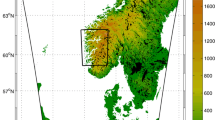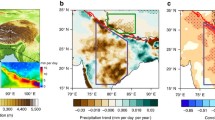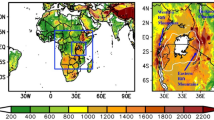Summary
The effect of mountains on the occurrence of precipitation systems on Taiwan island is very significant, especially as mountain areas occupy about two-thirds of the land-mass. The mountains are, on average, about 3 km high. To investigate the formation of precipitation systems influenced by Pacific high pressure systems, we selected five cases (May 24, 25 and 26, June 19 and 20 in 1987) during a field program, TAMEX (Taiwan Area Mesoscale Experiment, Kuo and Chen, 1990). In all cases most of the rainfall took place in the afternoon when the level of free convection (LFC) was at about the 1 km height. If the average wind (below 3 km in height) was from the south (May 25 and 26), higher amounts of precipitation would be found along the sloped areas of western and eastern Taiwan. Rainfall also occurred in southern and northern Taiwan. If the average wind was from the southwest (May 24), the precipitation pattern was similar to that on May 25, except over the plains area in southwest and northeast Taiwan, where the amount was less. However, if the prevailing wind direction changed little with height and the average wind was from the south-southeast (June 19), higher rainfall amounts occurred from northwestern to central Taiwan. If the average wind was from the south and wind direction changed little with height (June 20), higher rainfall amounts took place in northern and central Taiwan. A nonhydrostatic model was used to simulate the formation of precipitation systems in all five cases. Simulation results indicated that the mixing ratio of rainwater could occur on the upstream side of a mountain slope and in the central mountain areas, where topographic lifting from the environmental wind and an upslope flow due to surface heating were evident. On the downstream side of the mountain, upward motion due to lee-side convergence and upslope motion from surface heating would also help rain form.
Similar content being viewed by others
References
Akaeda, K., Reisner, J., Parsons, D., 1995: The role of mesoscale and topographically induced circulations in initiating a flash flood observed during the TAMEX project.Mon. Wea. Rev.,123, 1720–1739.
Banta, R. M., 1984: Daytime boundary-layer evolution over mountainous terrain. Part I: Observations of the dry circulations.Mon. Wea. Rev.,112, 340–356.
Banta, R. M., 1986: Daytime boundary-layer evolution over mountainous terrain. Part II. Observations of the dry circulations.Mon. Wea. Rev.,114, 1112–1130.
Banta, R. M., Schaaf, C. B., 1987: Thunderstorm genesis zones in the Colorado Rocky Mountains as determined by traceback of geosynchronous satellite images.Mon. Wea. Rev.,105, 463–476.
Chen, C.-S., Chen, W.-S., Deng, Z., 1991: A study of a mountain-generated precipitation system in northern Taiwan during TAMEX IOP 8.Mon. Wea. Rev.,119, 2574–2606.
Chen, Y.-L., Nash, A. J., 1994: Diurnal variation of surface airflow and rainfall frequencies on the island of Hawaii.Mon. Wea. Rev.,122, 34–56.
Durran, D. R., Klemp, J. B., 1982: The effects of moisture on trapped mountain lee waves.J. Atmos. Sci.,39, 2490–2506.
Johnson, R. H., Bresch, J. F., 1991: Diagnosed characteristics of Mei-Yu precipitation systems over Taiwan during the May–June 1987 TAMEX.Mon. Wea. Rev.,120, 2540–2557.
Karr, T. W., Wooten, R. L., 1976: Summer radar echo distribution around Limon, Colorado.Mon. Wea. Rev.,104, 728–734.
Kessler, E., 1969: On the distribution and continuity of water substance in atmospheric circulation.Meteor. Monogr.,32, Am. Meteor. Soc., 84pp.
Klemp, J. B., Wilhelmson, R. B., 1978: The simulation of three-dimensional convective storm dynamics.J. Atmos. Sci.,35, 1070–1096.
Kuo, J. T., Orville, H. D., 1973: A radar climatology of summertime convective clouds in the Black Hills.J. Appl. Meteor.,12, 357–368.
Kuo, Y.-H., Chen, G. T.-J., 1990: The Taiwan Area Mesoscale Experiment (TAMEX): An overview.Bull. Amer. Meteor. Soc.,71, 488–503.
Lin, Y.-L., Lin, N.-H., Weglarz, R. P., 1992: Numerical modeling studies of the lee mesolows, mesovortices, and mesocyclones with application to the formation of Taiwan mesolows.Meteorol. Atmos. Phys.,49, 43–76.
Lilly, D. K., 1962: On the numerical simulation of buoyant convection.Tellus,14, 148–172.
Orlanski, I., 1976: A simple boundary condition for unbounded hyperbolic flow.J. Computer Phys.,21, 251–269.
Author information
Authors and Affiliations
Additional information
With 13 Figures
Rights and permissions
About this article
Cite this article
Chen, C.S., Lin, C.Y. A preliminary study of the formation of precipitation systems under undisturbed conditions during TAMEX. Meteorl. Atmos. Phys. 64, 83–105 (1997). https://doi.org/10.1007/BF01044131
Received:
Revised:
Issue Date:
DOI: https://doi.org/10.1007/BF01044131




